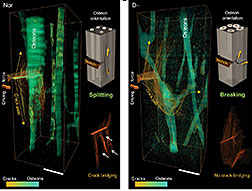- Number 394 |
- August 5, 2013
Of aging bones and sunshine

These 3D reconstructions of crack paths
show in the normal bone (left) pronounced
crack deflection by splitting along the
interfaces of the osteons accompanied by
the formation of crack bridges. In vitamin
D–deficient sample, the crack takes a
tortuous breaking path across the osteons
with no crack bridging.
Sunshine might be bad for your skin but it is good for your bones. A team of researchers working at the Advanced Light Source at DOE's Berkeley Lab has shown that the process by which bones age and become more fragile can be significantly accelerated through deficiency of vitamin D - the sunshine vitamin. Vitamin-D is essential for the body to absorb calcium. The body normally synthesizes vitamin D in the skin following exposure to sunlight – hence the “sunshine” moniker. However, when vitamin D serum concentrations become deficient, the body will remove calcium from bone to maintain normal calcium blood levels, hampering the formation of new bone mass and leading to rickets or osteomalacia. The ALS study revealed that low levels of vitamin D also induces premature aging of existing bone, making it far more brittle than it should be. “Restoring the normal level of vitamin D corrects the imbalance of mineralized and non-mineralized bone quantities and initiates simultaneous multiscale improvements in bone structure,” says Robert Ritchie, the Berkeley Lab materials scientist who led this research.
[Lynn Yarris, 510.486.5375,
lcyarris@lbl.gov]
